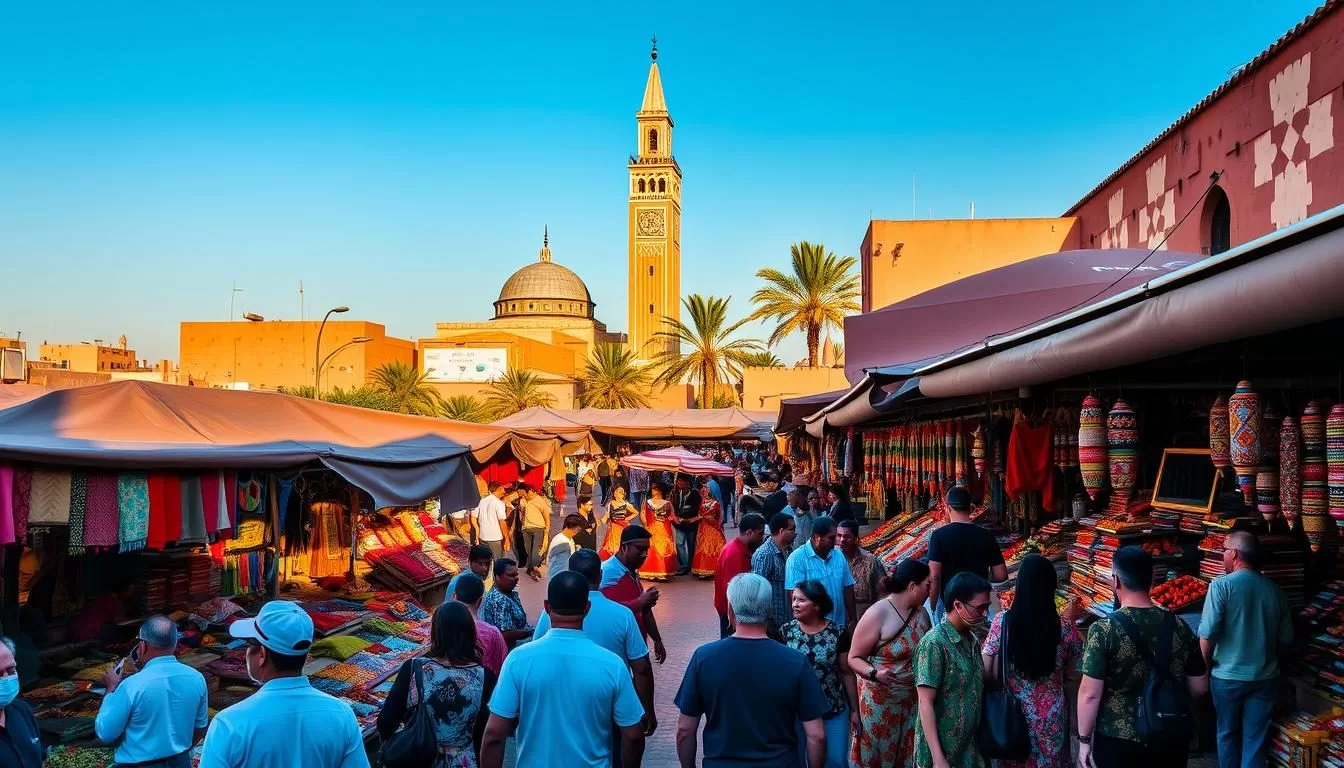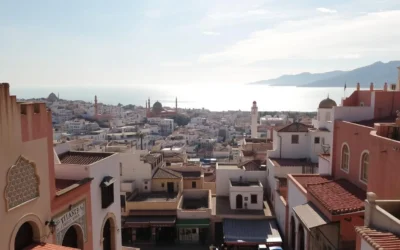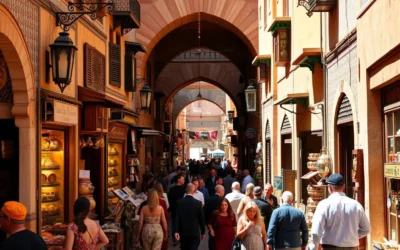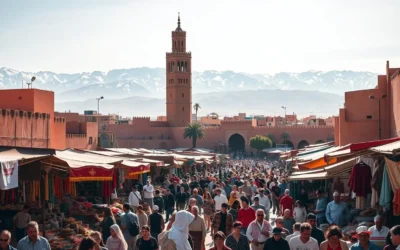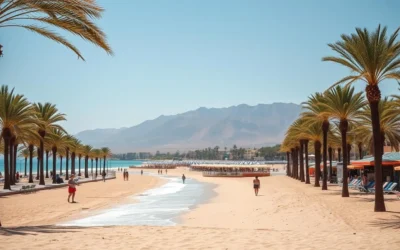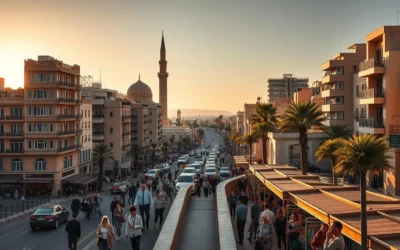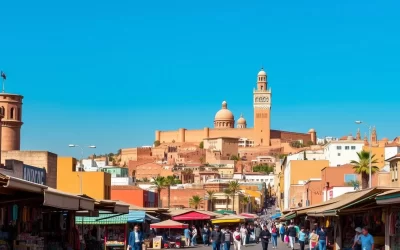Imagine immersing yourself in a land of rich cultural heritage and diverse traditions, where vibrant festivals celebrate the country’s history, music, art, and spirituality. As you plan your visit, timing your trip around these festivals can provide an unforgettable experience into authentic Moroccan culture.
From ancient rituals to modern celebrations, you’ll discover a unique glimpse into the soul of this North African nation. With a diverse range of themes, including religious celebrations, music events, cultural showcases, and agricultural festivities, there’s something for every type of traveler. You’ll be able to experience the country’s multicultural identity and historical legacy shaped by Berber, Arab, and Islamic influences.
The Cultural Significance of Moroccan Festivals
As you explore Morocco, you’ll discover that its festivals are deeply rooted in the country’s history and cultural identity. Moroccan festivals are a vibrant expression of the nation’s cultural diversity, reflecting the influences of Berber, Arab, and Islamic traditions.
These festivals provide a unique opportunity for communities to come together, celebrate their heritage, and express their cultural identity through music, dance, and traditional customs.
A Blend of Berber, Arab, and Islamic Traditions
Moroccan festivals represent a fascinating blend of Berber, Arab, and Islamic traditions that have coexisted and evolved together over centuries. The ancient Berber traditions form the foundation of many festivals, particularly in rural and mountain regions. Islamic influences are evident in religious festivals like Eid al-Fitr and Eid al-Adha.
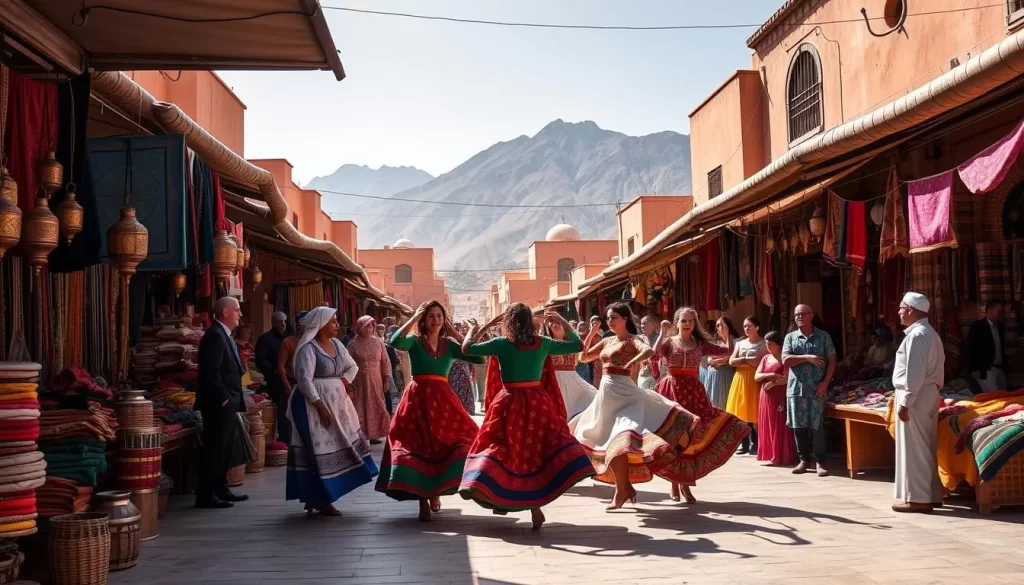
| Cultural Influence | Festival Traditions | Regional Significance |
|---|---|---|
| Berber | Agricultural celebrations, tribal gatherings | Rural and mountain regions |
| Arab | Music, poetry, culinary practices | Urban centers and cultural hubs |
| Islamic | Religious festivals like Eid al-Fitr and Eid al-Adha | National-wide celebrations |
How Festivals Showcase Morocco’s Cultural Diversity
By attending these festivals, you’ll witness how Morocco’s cultural diversity is not just preserved but celebrated, with each region proudly displaying its unique culture through distinctive music styles, traditional costumes, and local customs.
The communal nature of these festivals highlights the importance of social bonds in Moroccan society, where celebrations strengthen family ties and community relationships.
Gnaoua World Music Festival in Essaouira

Every June, the charming town of Essaouira transforms into a hub of musical diversity during the Gnaoua World Music Festival. This event celebrates the rich musical heritage of the Gnaoua people, a group with roots in sub-Saharan Africa, known for their unique blend of spiritual music.
History and Cultural Significance of Gnaoua Music
Gnaoua music has its roots in the traditions of the Gnaoua people, descendants of enslaved West Africans. It combines spiritual rituals, healing ceremonies, and hypnotic rhythms that have profoundly influenced Moroccan musical traditions. The Gnaoua World Music Festival has grown from a small cultural event to one of Africa’s most significant music festivals, attracting over 500,000 visitors annually.
What to Expect: Performances and Activities
When you attend the Gnaoua World Music Festival, you’ll experience traditional Gnaoua performances characterized by rhythmic beats, soulful melodies, and entrancing call-and-response singing that often leads to trance-like states. The festival isn’t limited to traditional performances; it creates unique musical fusions by bringing together Gnaoua masters with international jazz, blues, and contemporary musicians. Beyond music, you can participate in workshops on Gnaoua instruments like the guembri and qraqeb, attend cultural discussions, and explore art exhibitions.
Practical Tips for Attending
For the best experience, book your accommodation in Essaouira months in advance, as the city fills up quickly during the festival. Consider purchasing VIP passes if you want guaranteed seating at the main stage performances. The festival offers both ticketed events and free concerts in public spaces throughout Essaouira, making it accessible regardless of your budget.
Fes Festival of World Sacred Music
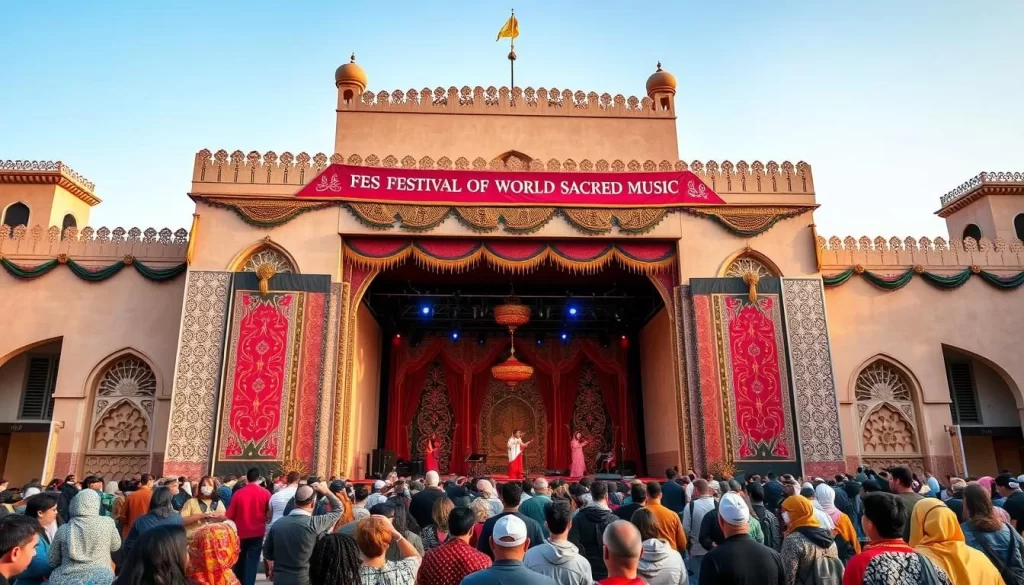
Every June, the ancient city of Fes transforms into a vibrant stage for the Fes Festival of World Sacred Music. This celebrated event brings together artists and musicians from around the globe to promote peace and cultural exchange.
Promoting Peace Through Musical Traditions
The Fes Festival of World Sacred Music was founded in 1994 following the Gulf War with a mission to create dialogue between cultures through the universal language of sacred music and spiritual traditions. It highlights the spiritual aspects of music, transcending cultural and religious boundaries.
Festival Highlights and Performances
The festival transforms Fes into a global stage where sacred music traditions from various religions come together. You can enjoy performances in stunning historical venues, including the magnificent Bab Al Makina palace gate and ancient madrasas. Beyond concerts, experience the Sufi Nights—free late-night mystical performances of trance-inducing music and whirling dervishes.
Navigating the Festival in Fes
To fully experience the diverse program, plan to spend at least 3-4 days in Fes. Consider hiring a local guide to navigate the various venues scattered throughout the labyrinthine medina. Purchase your tickets well in advance as the most popular performances sell out quickly.
Marrakech Popular Arts Festival
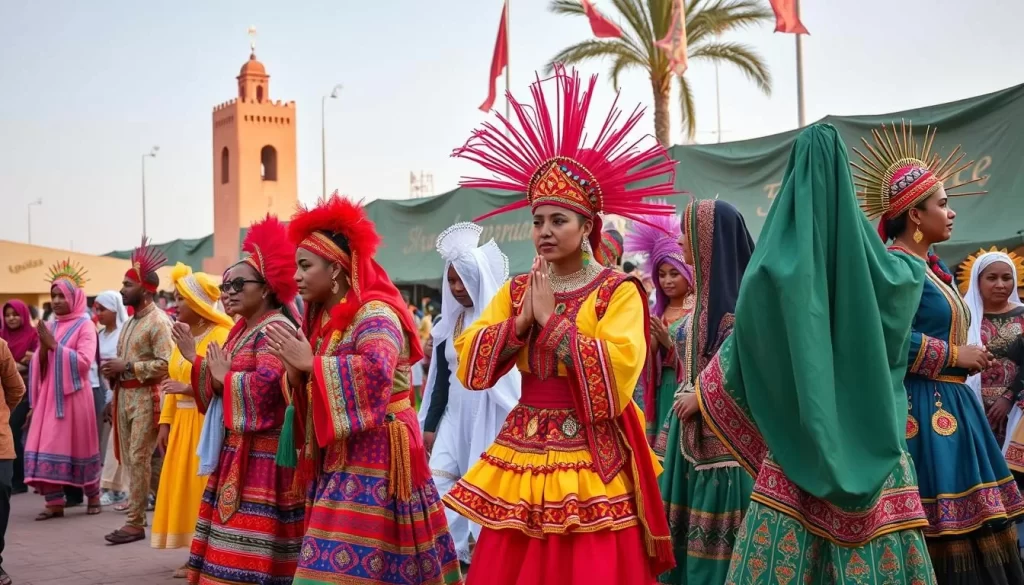
Every July, the city of Marrakech transforms into a vibrant cultural hub with the Marrakech Popular Arts Festival. This event is a celebration of Moroccan folk culture, featuring a wide range of artistic expressions, including music, dance, theater, and visual arts.
Traditional Performances and Street Art
The festival showcases diverse art forms, including Berber dancing, Gnaoua music, fire-swallowing acts, snake charmers, acrobatic displays, and storytelling performances. As you wander through Marrakech during the festival, you’ll encounter colorful parades with performers in traditional costumes moving through the streets, creating a vibrant atmosphere.
Best Venues and Viewing Spots
The magnificent El Badi Palace serves as the primary venue for evening performances, providing a dramatic backdrop for folklore troupes performing under the stars. Jemaa el-Fna square becomes even more animated during the festival, with additional performance circles forming throughout the day and night. To experience the best of the festival, arrive early at popular venues to secure good spots, especially for the opening and closing ceremonies.
Religious Celebrations: Eid al-Fitr and Eid al-Adha
Morocco comes alive during Eid al-Fitr and Eid al-Adha, celebrating these important Islamic festivals with communal prayers, feasting, and family gatherings. These events are not just significant religious observances but also a reflection of Morocco’s rich cultural heritage and customs.
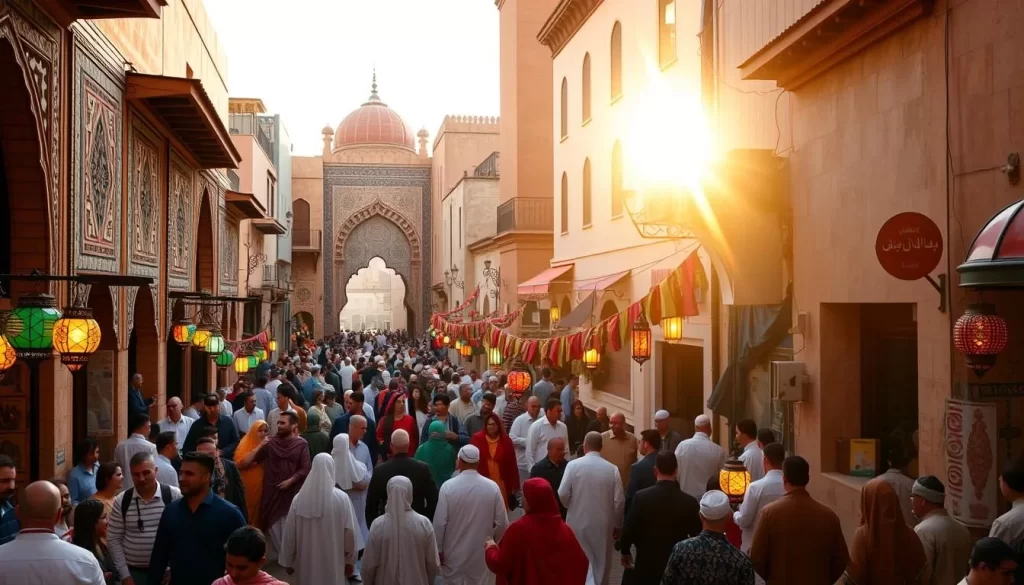
Significance in Moroccan Culture
Eid al-Fitr and Eid al-Adha are deeply ingrained in Moroccan culture, representing the country’s strong Islamic traditions and values of community and charity. Eid al-Fitr marks the end of Ramadan, the holy month of fasting, while Eid al-Adha commemorates the willingness of Ibrahim (Abraham) to sacrifice his son in obedience to God. Both celebrations involve special prayers, feasting, and the distribution of meat to the less fortunate, embodying the spirit of generosity and togetherness.
How Travelers Can Experience These Celebrations
As a traveler, you can immerse yourself in these significant celebrations by accepting invitations from local families to join their festivities, observing the morning prayers from a respectful distance, and exploring the vibrant markets that emerge before the celebrations. The day before each Eid is particularly interesting, with bustling activity in markets, hammams, and homes as everyone prepares for the day ahead. You can witness the preparation of traditional dishes like mrouzia during Eid al-Adha and sellu during Eid al-Fitr, experiencing the rich culinary heritage of Morocco.
| Celebration | Key Activities | Traditional Foods |
|---|---|---|
| Eid al-Fitr | Special prayers, family gatherings, gift-giving | Sellu (sweet flour-based treat) |
| Eid al-Adha | Ritual sacrifice of sheep, distribution of meat | Mrouzia (sweet lamb with raisins and almonds) |
Almond Blossom Festival in Tafraoute
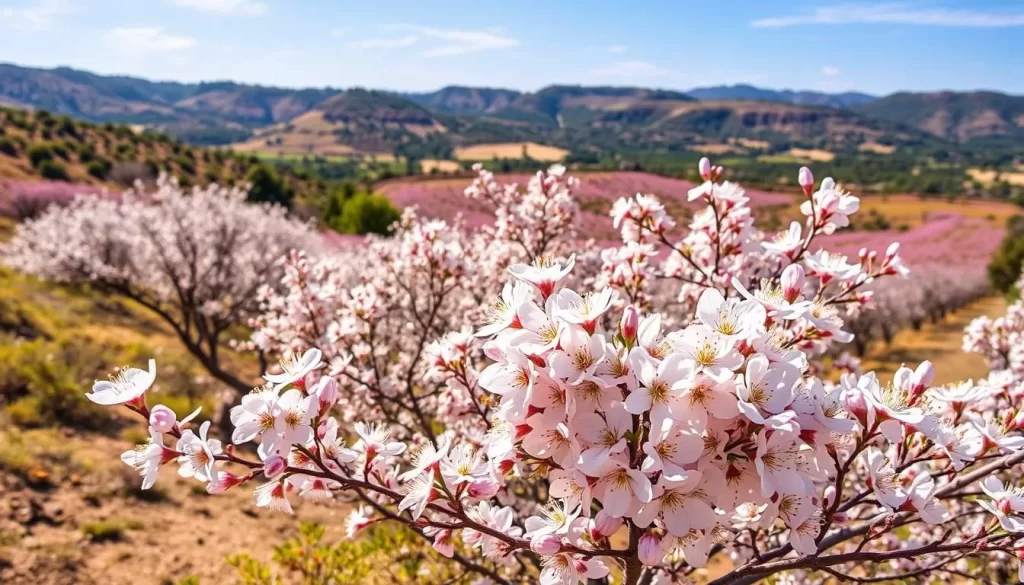
Experience the enchanting beauty of Tafraoute during the Almond Blossom Festival, a unique blend of nature and culture. This picturesque festival celebrates the blooming of almond trees in the Tafraout region, showcasing stunning landscapes and agricultural heritage.
Celebrating Nature and Berber Traditions
The Almond Blossom Festival takes place each February when the valleys of the Anti-Atlas Mountains transform into a breathtaking sea of pink and white almond blossoms. This celebration combines agricultural heritage with Berber cultural traditions, featuring local musicians and traditional dances.
Activities and Cultural Performances
During the festival, you can participate in guided walks through the almond groves, learning about the cultivation process and the historical importance of almonds to the region’s cuisine and economy. The festival also showcases traditional Berber music and dances, such as ahwash—a traditional form of group dancing and singing.
Mawazine Festival: Morocco’s International Music Scene
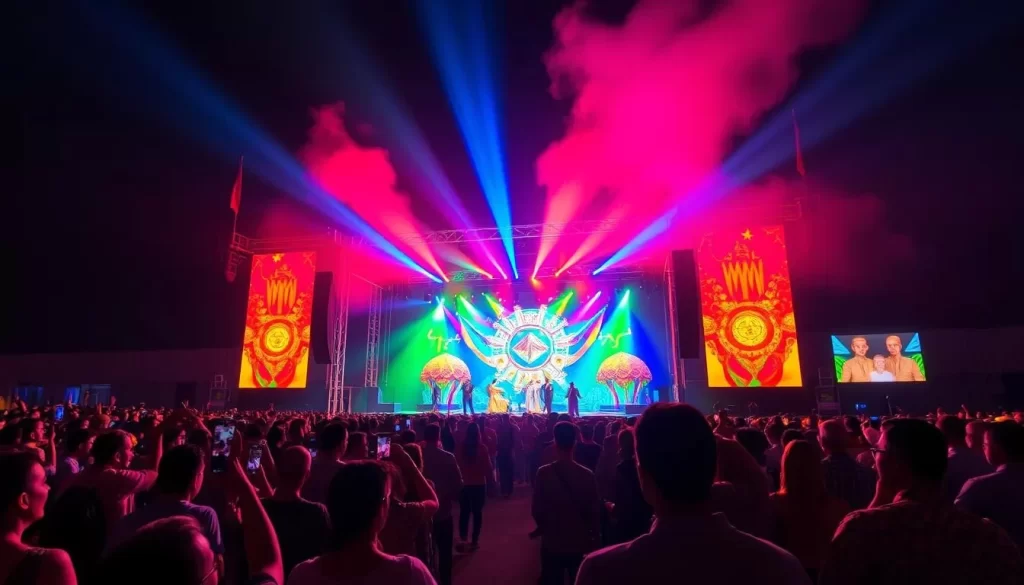
As one of Morocco’s largest music festivals, Mawazine brings international and local artists together, celebrating the country’s rich cultural diversity through world music. The festival has grown to become one of Africa’s largest, attracting over 2.5 million attendees annually to Rabat for nine days of performances across multiple genres.
World-Class Performances in Rabat
The Mawazine festival features a diverse lineup of musicians, including international superstars like Mariah Carey, Justin Timberlake, and Shakira, alongside celebrated Arab musicians and emerging Moroccan artists. The event utilizes multiple venues throughout Rabat, creating distinct musical environments that cater to a wide range of tastes.
Tips for Getting the Most Out of Mawazine
To fully enjoy the Mawazine festival, download the official festival app for real-time updates on performances. Arrive early at popular free concerts to secure good viewing spots, and consider purchasing VIP tickets for headliner shows. Planning your accommodation in Rabat in advance is also crucial, as the city fills up quickly during the event.
Planning Your Festival Visit to Morocco
To make the most of Morocco’s festival scene, it’s crucial to plan your visit strategically. Morocco hosts a wide range of festivals throughout the year, with the majority taking place during the spring and fall seasons when the weather is pleasant.
Best Times of Year for Festival Travel
The best time to visit Morocco for its festivals is during the spring (March to May) and fall (September to November). These periods offer pleasant weather and a plethora of cultural events. You can experience multiple festivals Morocco has to offer during these times.
Accommodation and Transportation Tips
It’s advisable to book your accommodation well in advance, especially in cities like Essaouira and Fes, where quality lodging can sell out quickly. Morocco’s transportation network is reliable, with high-speed rail connecting major cities and buses serving festival destinations. Plan your transportation in advance to ensure a smooth journey.
Cultural Etiquette for Festival Attendees
When attending festivals, respect local customs by dressing modestly, especially at religious events. Learning basic Arabic or French phrases can also enhance your experience and provide a better opportunity to engage with locals. Being mindful of these aspects will make your festival visit more enjoyable and culturally enriching.

Conclusion: Experiencing the Heart of Morocco Through Its Festivals
Experiencing Morocco’s festivals is a journey into the heart of the country’s culture. By attending these vibrant celebrations, you’ll gain a deeper understanding of Morocco’s rich heritage and the traditions that shape its identity.
Morocco’s festivals offer you a unique window into the soul of this diverse nation, where ancient traditions blend seamlessly with contemporary expressions. At any given time, you can experience the country’s cultural diversity firsthand, engaging with local communities and savoring the warmth of Moroccan hospitality.
The diversity of Morocco’s festival calendar ensures there’s something to discover year-round, whether you’re drawn to spiritual celebrations, musical performances, or culinary traditions. As you plan your visit to coincide with these festivals in Morocco, you’ll have the opportunity to witness the country’s authentic culture. By approaching these festivals with curiosity and respect, you’ll not only experience the heart of Morocco but also contribute to the preservation of its rich cultural heritage for generations to come, making the most of your time in this beautiful country.
The above is subject to change.
Check back often to TRAVEL.COM for the latest travel tips and deals.
Here are some Tours & Sightseeing suggestions that might pique your interests!
